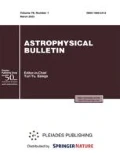Abstract
We present the analysis of the optical radiation of the young pre-cataclysmic variable TW Crv. Spectroscopic and photometric observations were obtained at the SAO RAS 6-m BTA telescope and at the Russian-Turkish RTT-150 telescope. The light curves of the system posses nearly sinusoidal shapes with the amplitudes of Δ m > 0.m7, what is typical for young pre-cataclysmic variables with sdO-subdwarfs and orbit inclinations of less than 45◦. The optical spectrum contains dominant radiation of the hot subdwarf with the HI and He II absorption lines and strong emission lines, which are formed in the atmosphere of the secondary owing to the reflection effects. Radial velocities of the cool star were measured by analyzing the λλ 4630–4650 Å Bowen blend, which for the first time allowed to determine the component masses. A numerical simulation of the light curves and spectra of TW Crv, obtaining a complete set of systems fundamental parameters was carried out. The hot star parameters prompt its belonging to the sdOsubdwarf class at the stage of transition to the cooling white dwarf sequence. The absence of its observable planetary nebula is caused by a long-lasting evolution of the system after the common envelope state. The secondary component has a luminosity excess, which is typical for other young sdO-subdwarf precataclysmic variables. Its position on the “age−−luminosity excess” diagram points at the accuracy of the obtained set of TW Crv fundamental parameters and at the similarity of its evolutionary and physical conditions with that of other BE UMa-type objects.
Similar content being viewed by others
References
H. Ritter, Astron. and Astrophys. 169, 139 (1986).
H. Ritter and U. Kolb, Astron. and Astrophys. 404, 301 (2010).
V. V. Shimansky, N. V. Borisov, and N. N. Shimanskaya, Astronomy Reports 47, 763 (2003).
M. R. Schreiber and B. T. Gänsicke, Astron. and Astrophys. 406, 305 (2003).
V. V. Shimansky, S. A. Pozdnyakova, N. V. Borisov, et al., Astrophysical Bulletin 64, 349 (2009).
V. V. Shimanskii, N. V. Borisov, N. A. Sakhibullin, and A. E. Surkov, Astronomy Reports 48, 563 (2004).
N. N. Samus’, V. P. Goranskii, O. V. Durlevich, et al., Astronomy Letters 29, 468 (2003).
R. M. Cutri, M. F. Skrutskie, S. van Dyk, et al., VizieR Online Data Catalog: II/246 (2003).
K. M. Exter, D. L. Pollacco, P. F. L. Maxted, et al., Monthly Notices Royal Astron. Soc. 359, 315 (2005).
T. Ribeiro and R. Baptista, Astron. and Astrophys. 526, A150 (2011).
A. Chen, D. O’Donoghue, R. S. Stobie, et al., Monthly Notices Royal Astron. Soc. 275, 100 (1995).
V. V. Shimanskii, N. V. Borisov, S. A. Pozdnyakova, et al., Astronomy Reports 52, 558 (2008).
V. V. Shimansky, N. V. Borisov, D. N. Nurtdinova, et al., Astronomy Reports 59, 199 (2015).
V. L. Afanasiev and A. V. Moiseev, Astronomy Letters 31, 194 (2005).
R. C. Bohlin, Astron. J. 111, 1743 (1996).
J. L. Greenstein, Astrophys. J. 144, 496 (1966).
R. C. Bohlin, ASP Conf. Ser. 364, 315 (2007).
M. K. Abubekerov, E. A. Antokhina, A. M. Cherepashchuk, and V. V. Shimanskii, Astronomy Reports 50, 544 (2006).
V. V. Shimanskii, N. V. Borisov, N. A. Sakhibullin, and D. V. Sheveleva, Astronomy Reports 52, 479 (2008).
N. A. Sakhibullin and V. V. Shimanskii, Astronomy Reports 41, 378 (1997).
N. A. Sakhibullin and V. V. Shimanskii, Astronomy Reports 40, 723 (1996).
D. V. Ivanova, N. A. Sakhibullin, and V. V. Shimanskii, Astronomy Reports 46, 390 (2002).
F. Castelli and R. L. Kurucz, arXiv:astro-ph/0405087 (2004).
V. F. Suleimanov, Astronomy Letters 22, 92 (1996).
R. L. Kurucz, Mem. Soc. Astron. Ital. Suppl. 8, 14 (2005).
V. F. Suleymanov, Astron. Astrophys. Trans. 2, 197 (1992).
R. Kurucz, CD-ROM No. 20 (Smithsonian Astrophysical Observatory, Cambridge, 1994).
S. E. Naersisian, A. V. Shavrina, and A. A. Yaremchuk, Astrofizika 30, 147 (1989).
C. R. Vidal, J. Cooper, and E.W. Smith, Astrophys. J. Suppl. 25, 37 (1973).
H. R. Griem, Astrophys. J. 132, 883 (1960).
R. L. Kurucz and I. Furenlid, Special Report, No. 387 (Smithsonian Astrophysical Observatory, Cambridge, 1979).
A. Unsold, Physik der Sternatmospheren (Springer, Berlin–Gottingen–Heidelberg, 1955).
N. N. Shimanskaya, I. F. Bikmaev, and V. V. Shimansky, Astrophysical Bulletin 66, 332 (2011).
N. A. Sakhibullin, Trudy Kazansk. Gor. Astron. Obs. 48, 9 (1983).
V. V. Shimanskii, E. A. Karitskaya, N. G. Bochkarev, et al., Astronomy Reports 56, 741 (2012).
E. Anders and N. Grevesse, Geochim. Cosmochim. Acta 53, 197 (1989).
V. Straiżys, Multicolor stellar photometry. Photometric systems and methods (Mokslas Publisher, Vilnius, 1977).
A. A. Mitrofanova, V. V. Shimansky, N. V. Borisov, et al., Astronomy Reports 60, 252 (2016).
A. C. Wawrzyn, T. S. Barman, H. M. Günther, et al., Astron. and Astrophys. 505, 227 (2009).
D. H. Ferguson and T. A. James, Astrophys. J. Suppl. 94, 723 (1994).
V. V. Shimansky, S. A. Pozdnyakova, N. V. Borisov, et al., Astronomy Letters 34, 423 (2008).
T. Bloecker, Astron. and Astrophys. 299, 755 (1995).
L. Girardi, A. Bressan, G. Bertelli, and C. Chiosi, Astron. and Astrophys. Suppl. 141, 371 (2000).
Author information
Authors and Affiliations
Corresponding author
Additional information
Original Russian Text©V.V. Shimansky, A.A.Mitrofanova, N.V. Borisov, S.N. Fabrika, A.I. Galeev, 2016, published in Astrofizicheskii Byulleten’, 2016, Vol. 71, No. 4, pp. 497–509.
Rights and permissions
About this article
Cite this article
Shimansky, V.V., Mitrofanova, A.A., Borisov, N.V. et al. On the formation of TW Crv optical radiation. Astrophys. Bull. 71, 463–474 (2016). https://doi.org/10.1134/S199034131604009X
Received:
Accepted:
Published:
Issue Date:
DOI: https://doi.org/10.1134/S199034131604009X



